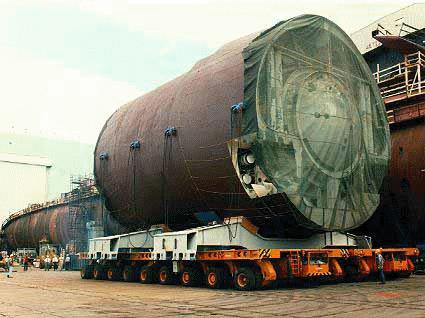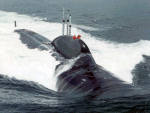
Hi Ray,
please let me coming back on your interesting topic in terms of HY 80.
Since it appears that the major use of HY 80 can be seen in maritime applications, I have spoken meanwhile with a good colleague of mine who is mainly responsible for welding in shipbuilding and offshore.
He again had some very interesting knowledge of this apparently "mysterious" material and he could recommend me some interesting literature to study further, even the specifications of the "Germanischer Lloyd" (see also
http://www.gl-group.com/start.htm) who is as I suppose surely one of the most important institutions in shipbuilding and maritime construction (perhaps even comparable with the ASME??).
And thus I had a look into the:
"Germanischer Lloyd - Rules for Classification and Construction / Materials and Welding / Metallic Materials / Special Materials for Naval Ships"
But before continuing with the technical facts I could find out by studying the literature above, please let me come first to what my colleague has told my on this material.
He told me that HY 80 as well as HY 100 (~700 MPa yield strength) is - as Phil Thomas and Henry "ssbn 727" have pointed out already (Henry!! Great photos!!) - very often used for building submarines or the hulls of submarines, respectively. As I questioned the comparability between the ASTM 656 Grade 80 and HY 80, since they appear to have similar yield strengths, he confirmed this as being the truth but... as he told me, the HY 80 does have higher notched impact strength for even lower temperatures. This again makes this steel so excellently suitable for even e.g. submarines which are being used under most different conditions (warmer Pacific waters as well as colder Atlantic waters) and severe surrounding circumstances (very high pressures). As well the corrosion resistance - so far as my colleague told me - may be an issue the HY 80 can meet in a better way compared with the ASTM 656 Grade 80. In terms of welding he has informed me, that - even under considering the technical requirements as being valid for quenched and tempered High Strength Low Alloy Steels - the HY 80 is a normally excellently weldable material. An interesting detail he could give me on the usage on the consumables. Normally Flux Cored Wires were mainly used to joining the often large wall thickness plates. Meanwhile whereas, in particular in the United Kingdom, the HY 80 is being processed more and more by using solid wires of particular composition which - as been found out - had a better behavior in regard to the peculiarity of the coarsened grain zone (narrower width) as well the weld metal deposits grain size seemed to be influenced positively. However, the latter under reserve and to my best knowledge which I have received by my experienced colleague. So if anybody of you fellows have different information in regard to the welding filler materials, used to join larger wall thicknessed HY 80, any kind of correction is - as always -greatly appreciated!
So far, please let me now continue with the technical information about HY 80, as the "Germanischer Lloyd" does see and treat this interesting material.
1. The script as mentioned above contains the scope of hot-rolled pressure vessel and special steel grades with wall thicknesses lower or equal to 150 mm (~6 inch). The scope contains hereby the steel grades HY 80 (Germanischer Lloyd designation GL M-550), HY 100 (Germanischer Lloyd designation GL M-700) and HY 130 (Germanischer Lloyd designation GL M-900). As one can see by having a look upon the GL designations, the steels are described by using their yield strength (0.2 yield). Thus the HY 80 has a yield strength of ~550 MPa, the HY 100 has a yield strength of ~ 700 MPa and the HY 130 has a yield strength of ~ 900 MPa.
2. The HY 80 has the German alloy designation 15 NiCrMo 10-6 as well, which shows that it is a Nickel Chromium Molybdenum Steel having a mean Carbon content of 0.15%. I have prepared a table, please see also the attached HY_80_Analysis.pdf, which shows the chemical composition of both HY 80 as the higher alloyed HY 100 quenched and tempered base material.
3. HY 80 is required to be produced by using the steel making methods either AOD (Argon Oxygen Decarburization, see also
http://en.wikipedia.org/wiki/Argon_Oxygen_Decarburization), or VOD (Vacuum Oxygen Decarburization, see also
http://www.energysolutionscenter.org/HeatTreat/MetalsAdvisor/iron_and_steel/process_descriptions/raw_metals_preparation/steelmaking/ladle_metallurgy/ladle_metallurgy_equipment.htm, or VODC (Vacuum Oxygen Decarburization Converter, see also
http://www.metsofoundries.com/foundries/MFsteel.nsf/WebWID/WTB-040818-2256E-063B3/$File/Vaculok_Steels.pdf).
4. Interesting is what The Germanischer Lloyd does describe on the "assessment on weldability" (Beurteilung der Schweißeignung). Since the base material has a more or less cold cracking susceptibility - as to be observed rather often in this group of steels - the Germanischer Lloyd assesses the weldability by using the following Carbon Equivalent formula:
Pcm = C + Si/30 + Mn/20 + Cu/20 + Ni/60 + Cr/20 + Mo/15 + V/10 + 5B [%]
5. Basis for the calculation above is the steel's melt analysis. The maximum "Pcm" value however has to be agreed between the manufacturer and the classification society, in even this particular case - the Germanischer Lloyd.
6. The steel must be delivered in an annealed condition
7. The minimum annealing temperatures for HY 80 are:
650 °C (1202 °F) for a wall thickness lower or equal to 60 mm (~ 2.4 inch) and
635 °C (1175 °F) for a wall thickness higher 60 mm and lower or equal to 150 mm.
8. The mechanical properties of the HY 80 are:
- 0.2 Yield Strength: 550 - 690 MPa (~ 79.8 KSI - ~ 100 KSI)
- Yield-Tensile Ratio: 0.9 for plates (0.92 for bars and profiles)
- Tensile Strength: 650 MPa (~ 94.3 KSI)
- Elongation at break: 19%
- Longitudinal CV Notch Impact Toughness at -85°C (-121 °F): Not tested
- Transversal CV Notch Impact Toughness at -85°C (-121 °F): 50 Joule
Well Ray, as you can see, the material you have chosen to have a look upon is a very interesting one both from the metallurgical as well as from the processing point of view. And your assumption that it is just approximately similar with the ASTM 656 Grade 80 High Strength Low Alloy Structural Steel was right, at least as far as I could find out.
So finally once again a personal "Thanks" for initiating this interesting topic and thus to drive me for busying myself a little more intensive with this material. I guess I have learned again somewhat new and I hope the descriptions above may have been a little help for YOU - since this was the very first goal at all!
My very best regards,
Stephan
P.S. Thanks for your doubtless statement in terms of my participation in the forum!! A great thanks to John (jrw159) as well! What a privilege to have you fellas aside!
















